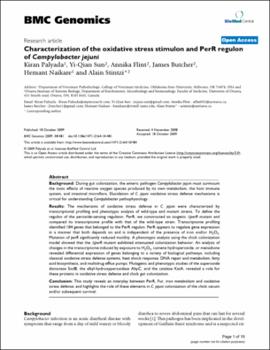| dc.contributor.author | Palyada, Kiran | |
| dc.contributor.author | Sun, Yi-Qian | |
| dc.contributor.author | Flint, Annika | |
| dc.contributor.author | Butcher, James | |
| dc.contributor.author | Naikare, Hemant | |
| dc.contributor.author | Stintzi, Alain | |
| dc.date.accessioned | 2018-11-09T21:10:49Z | |
| dc.date.available | 2018-11-09T21:10:49Z | |
| dc.date.issued | 2009-10-18 | |
| dc.identifier | oksd_palyada_characterizatio_2009 | |
| dc.identifier.citation | Palyada, K., Sun, Y.-Q., Flint, A., Butcher, J., Naikare, H., & Stintzi, A. (2009). Characterization of the oxidative stress stimulon and PerR regulon of Campylobacter jejuni. BMC Genomics, 10, Article 481. https://doi.org/10.1186/1471-2164-10-481 | |
| dc.identifier.uri | https://hdl.handle.net/11244/302059 | |
| dc.description.abstract | Background: During gut colonization, the enteric pathogen Campylobacter jejuni must surmount the toxic effects of reactive oxygen species produced by its own metabolism, the host immune system, and intestinal microflora. Elucidation of C. jejuni oxidative stress defense mechanisms is critical for understanding Campylobacter pathophysiology. | |
| dc.description.abstract | Results: The mechanisms of oxidative stress defense in C. jejuni were characterized by transcriptional profiling and phenotypic analysis of wild-type and mutant strains. To define the regulon of the peroxide-sensing regulator, PerR, we constructed an isogenic [delta]perR mutant and compared its transcriptome profile with that of the wild-type strain. Transcriptome profiling identified 104 genes that belonged to the PerR regulon. PerR appears to regulate gene expression in a manner that both depends on and is independent of the presence of iron and/or H2O2. Mutation of perR significantly reduced motility. A phenotypic analysis using the chick colonization model showed that the [delta]perR mutant exhibited attenuated colonization behavior. An analysis of changes in the transcriptome induced by exposure to H2O2, cumene hydroperoxide, or menadione revealed differential expression of genes belonging to a variety of biological pathways, including classical oxidative stress defense systems, heat shock response, DNA repair and metabolism, fatty acid biosynthesis, and multidrug efflux pumps. Mutagenic and phenotypic studies of the superoxide dismutase SodB, the alkyl-hydroxyperoxidase AhpC, and the catalase KatA, revealed a role for these proteins in oxidative stress defense and chick gut colonization. | |
| dc.description.abstract | Conclusion: This study reveals an interplay between PerR, Fur, iron metabolism and oxidative stress defense, and highlights the role of these elements in C. jejuni colonization of the chick cecum and/or subsequent survival. | |
| dc.format | application/pdf | |
| dc.language | en_US | |
| dc.publisher | BioMed Central | |
| dc.rights | This material has been previously published. In the Oklahoma State University Library's institutional repository this version is made available through the open access principles and the terms of agreement/consent between the author(s) and the publisher. The permission policy on the use, reproduction or distribution of the material falls under fair use for educational, scholarship, and research purposes. Contact Digital Resources and Discovery Services at lib-dls@okstate.edu or 405-744-9161 for further information. | |
| dc.title | Characterization of the oxidative stress stimulon and PerR regulon of Campylobacter jejuni | |
| osu.filename | oksd_palyada_characterizatio_2009.pdf | |
| dc.description.peerreview | Peer reviewed | |
| dc.identifier.doi | 10.1186/1471-2164-10-481 | |
| dc.description.department | Veterinary Pathobiology | |
| dc.type.genre | Article | |
| dc.type.material | Text | |
| dc.subject.keywords | menadione | |
| dc.subject.keywords | cumene hydroperoxide | |
| dc.subject.keywords | oxidant exposure | |
| dc.subject.keywords | H2O2 exposure | |
| dc.subject.keywords | oxidative stress defense | |
